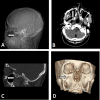Effectiveness and Safety of Radiofrequency Thermocoagulation Treatment Guided by Computed Tomography for Infraorbital Neuralgia Following Failed Conservative Treatment: A Retrospective Study
- PMID: 36974307
- PMCID: PMC10039627
- DOI: 10.2147/JPR.S395420
Effectiveness and Safety of Radiofrequency Thermocoagulation Treatment Guided by Computed Tomography for Infraorbital Neuralgia Following Failed Conservative Treatment: A Retrospective Study
Abstract
Purpose: To evaluate the effectiveness and safety of CT-guided radiofrequency thermocoagulation (RFT) for the treatment of infraorbital neuralgia following the failure of conservative management.
Patients and methods: This was a single center, retrospective study which included 196 patients between the ages of 37 to 90 years, who suffered from infraorbital neuralgia, and had undergone CT-guided RFT treatment. The medical records of these patients were retrieved between January 7, 2015 and February 5, 2020, and the patients were followed up for 2 years. Follow-up outcomes included Numerical Rating Scale (NRS) scores, dosage of carbamazepine, time to take effect, status of recurrence and side effects. The effective rate was defined as the percentage of patients with postoperative NRS score reduction of >50%.
Results: The effective rates were 92.9%, 100%, 100%, 100%, 93.4% and 85.7% on the same day, week 1, month 1, month 6, year 1 and year 2 after RFT, respectively. After RFT, the postoperative NRS scores and dosage of carbamazepine were significantly reduced than those preoperatively (P < 0.05). The median time to take effect was zero day. Twenty-eight patients with recurrence underwent RFT again and achieved complete pain relief. All patients experienced numbness in the infraorbital nerve innervation area and the numbness scores gradually decreased over time.
Conclusion: CT-guided RFT treatment may be an effective and safe technique for pain relief in patients with infraorbital neuralgia following failed results from conservative treatment.
Keywords: effectiveness; infraorbital neuralgia; radiofrequency thermocoagulation; retrospective study; safety.
© 2023 Sun et al.
Conflict of interest statement
The authors declare that they have no conflicts of interest in this work.
Figures





Similar articles
-
Effectiveness and Safety of Pulsed Radiofrequency Treatment Guided by Computed Tomography for Refractory Neuralgia of Infraorbital Nerve: A Pilot Study.Pain Physician. 2015 Sep-Oct;18(5):E795-804. Pain Physician. 2015. PMID: 26431133
-
A Retrospective Comparison of Low-Temperature Plasma Ablation and Radiofrequency Thermocoagulation of the Thoracic Nerve Root for Refractory Postherpetic Neuralgia.Pain Physician. 2024 May;27(4):243-251. Pain Physician. 2024. PMID: 38805531
-
Long-term Follow-up of the Effectiveness and Safety of High-voltage Pulsed Radiofrequency Treatment for Infraorbital Neuralgia: A Retrospective Study.Pain Physician. 2024 Sep;27(7):E751-E759. Pain Physician. 2024. PMID: 39353123
-
Effects of Supraorbital Foramen Variations on the Treatment Efficacy of Radiofrequency Therapy for V1 Trigeminal Neuralgia: A Retrospective Study.Pain Res Manag. 2020 Feb 26;2020:8142489. doi: 10.1155/2020/8142489. eCollection 2020. Pain Res Manag. 2020. PMID: 32184911 Free PMC article. Review.
-
Radiofrequency thermoablation of the peripheral branches of trigeminal nerve versus the Gasserian ganglion for treating idiopathic trigeminal neuralgia: A systematic review and meta-analysis.J Clin Neurosci. 2022 Oct;104:42-47. doi: 10.1016/j.jocn.2022.08.005. Epub 2022 Aug 11. J Clin Neurosci. 2022. PMID: 35963063
Cited by
-
Effectiveness and Safety of Platelet-Rich Plasma Combined with Pulsed Radiofrequency to Treat Patients with Infraorbital Neuralgia: A Propensity Score-Matched Analysis of a Multi-Center, Prospective Cohort Protocol.J Pain Res. 2025 Mar 26;18:1643-1656. doi: 10.2147/JPR.S505263. eCollection 2025. J Pain Res. 2025. PMID: 40165939 Free PMC article.
References
-
- International Association for the Study of Pain. Classification of Chronic Pain. International Association for the Study of Pain; 1994.
LinkOut - more resources
Full Text Sources
Research Materials

